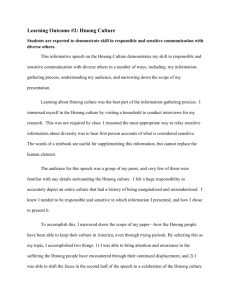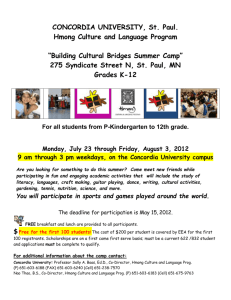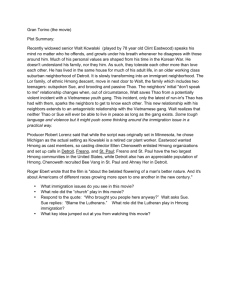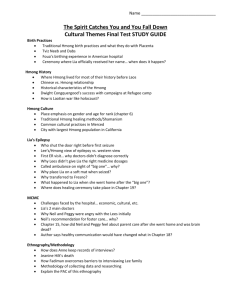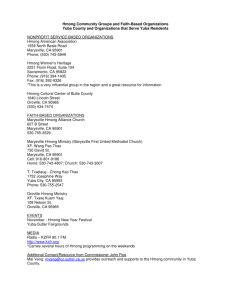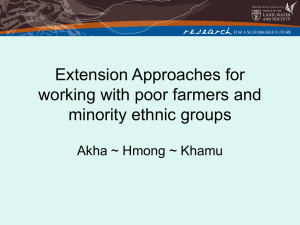Project Forward - University of Wisconsin
advertisement
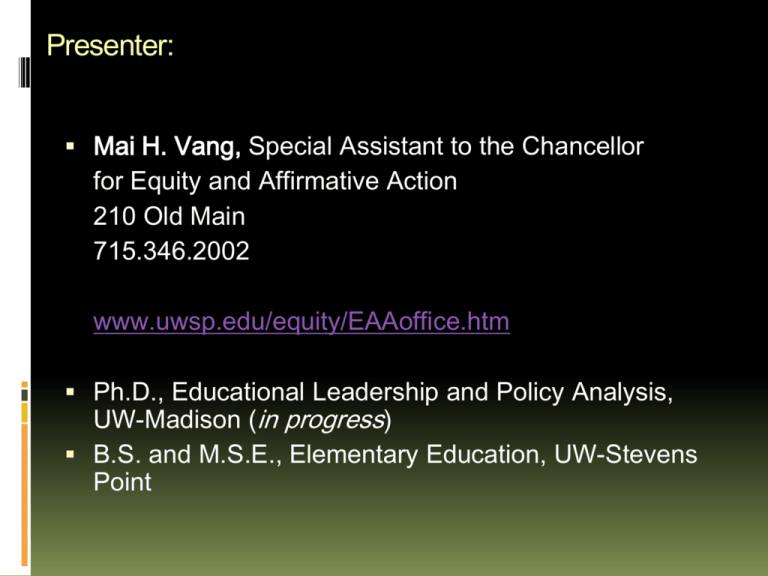
Presenter: Mai H. Vang, Special Assistant to the Chancellor for Equity and Affirmative Action 210 Old Main 715.346.2002 www.uwsp.edu/equity/EAAoffice.htm Ph.D., Educational Leadership and Policy Analysis, UW-Madison (in progress) B.S. and M.S.E., Elementary Education, UW-Stevens Point ED 205 Presentation: The Hmong Personal experience Population History Language Clanship Religion Best practices for Hmong students Hmong in America: Refugees of War “A person who owing to a well-founded fear of being persecuted for reasons of race, religion, nationality, membership of a particular social group or political opinion, is outside the country of his nationality and is unable or, owing to such fear, is unwilling to avail himself of the protection of that country; or who, not having a nationality and being outside the country of his former habitual residence as a result of such events, is unable or, owing to such fear, is unwilling to return to it." (United Nations Convention Relating to the Status of Refugees web site) Population (World) Asia China – 6,000,000 Vietnam – 787,604 Laos – 315,000 Thailand – 124,000 Burma – 2-3,000 Western Nations United States – 200,000-250,000 France – 8,000 Australia – 1,800 Canada – 767 French Guyana – 500-1,000 Germany – 70 (Tapp, Australian National University, Canberra, Australia) Population (USA) Top 10 Hmong Populations by State 1. California – 65,095 2. Minnesota – 41,800 3. Wisconsin – 33,791 4. North Carolina – 7,093 5. Michigan – 5,383 6. Colorado – 3,000 7. Oregon – 2,101 8. Georgia – 1,468 9. Washington – 1,294 10. Massachusetts – 1,127 (U.S. 200 Census, 2000) Population (WI) 33,791 Hmongs living in WI. Hmong community counts about 50,000 Hmongs living in 2000 US census: WI. Language and culture cited as probable causes for undercount. (Lee, 2005) In 2004, United Refugee Services estimated about to 3,700 refugees to immigrate to WI. 2,500 Demographics Median Age: 16.1 Years (35.3 years among the U.S. Pop.) Age: 56 % of the Hmong Population is under 18 Years Old (25.7% of the U.S. Pop.) Average Hmong Household Size per Housing Unit: 6.27 persons (2.59 persons among the U.S. Pop.) History 2000-2700 B.C. Mesopotamian: Middle East origin “Tab xuabzeb hav suabpuam” China & Southeast Asia Southeast Asia Ancient China Hmong occupied the Yellow River region. Ruled with a loose federation with republican features. Left in the later parts of 18th Century due to ethnic persecution. Timeline (1776-present) 1776-1860 A.D.: migrate out of China 1963-1975: The Vietnam Conflict and the Secret War 1975: migrate out of Laos into Thailand 1976 to Present Time: migrate to the U.S., France, Australia, French Guyana, Canada, and Germany December 2003: resettlement of 15,000 Hmong refugees June 2004: First Hmong refugees arrived in Minnesota, California, Wisconsin and other states Language Sino-Tibetan language, 1300 B.C. Monosyllabic and tonal (examples: Japanese, Korean, Norwegian and Swedish) Barrows from Ancient Chinese Mandarin (example: “txivlaum huabxeeb”) Written Language Original written language was lost Paj Ntaub (flower cloths) Developed in 1950, F. M. Savina (Quincy, 1997) Eight tone marks (b, -, s, j, v, m, g, d) Religion Traditional Belief system (70%): three elements: Animism- “all life is produced by a spiritual force” or “all things in nature have souls” Ancestor worship Shamanism Other religions practiced: Christianity (1/3), Buddhism or Islam (Percentages are provided by Lee and Pfeifer, 2006) Family Delineated roles Patrilineality Clans Clanship Basic social and political organization 12 original clans Branched out to 20 clans worldwide, 18 in the US (Thao, 1999) Clanship continued… Members of given clan are viewed as relatives (Lee, 2005) Individual takes his or her father's clan name and remains a member for life (Patrilineal) However, Hmong women who marry take on the identities of their husbands' clans Clans provide social support, mutual assistance, and legal and mediation assistance (Lee and Pfeifer, 2006) Communication Most families do not teach reading and writing in the Hmong language. Certain research argue that Hmong learners lean toward being visual learners High value placed on education but there may be a lack of resources or personal experience to personally teach their children academic skills Communication must be established between parents and schools to better understand and respect the other’s potential role Intergenerational conflicts: families and elders vs. peer culture Best practices Cultural practices: i.e., gender roles, handshakes, eye contact, and humble behavior (silent period) Medicinal marks (cupping) and religious accessories Diversity: subgroups, i.e., dialect, religion, socioeconomics (funding), and generation Stereotypes: popular account of being primitive and static people School functions: evening social with purpose of learning school forms/procedures and roles of individual students (oldest child policy) Celebrate Diversity! Resources Hamilton-Merritt, J. (1993). Tragic Mountains: The Hmong, The Americans, and the Secret War for Laos, 1942-1992. Bloomington. Indian University Press. Lee, Stacey J. (2005). Up Against Whiteness: Race, School, and Immigrant Youth. New York: Teachers College Press. Lee, Stacy J. (2001). More than “Model Minorities” or “Delinquents”: A Look at Hmong American High School Students. Harvard Educational Review, 71(3), 505-527. McClain, Leslie & Xiong, Kao. (2005). Continuing the Promise: Recruiting and Preparing Hmong American Educators for North Central Wisconsin. Hmong Studies Journal, 6:1-16. Qincy, K. (1997). Hmong: History of a People. Eastern Washington University Press. Thao, Paoze. (1999). Mong Education at the Crossroads. Lanham: University Press of America. Building Bridges: Teaching about the Hmong in Our Community http://hmongstudies.org/BuildingBridgesGeneralPresentation2006Version.pdf Hmong Center http://www.hmongcenter.org/ Hmong Net http://www.hmongnet.org/hmong-au/ozintro.htm OHCHR http://www.unhchr.ch/html/menu3/b/o_c_ref.htm www.refugeesusa.org/uploadedFiles/Investigate/Publications_and_Archives/Refugee_Reports/St...

